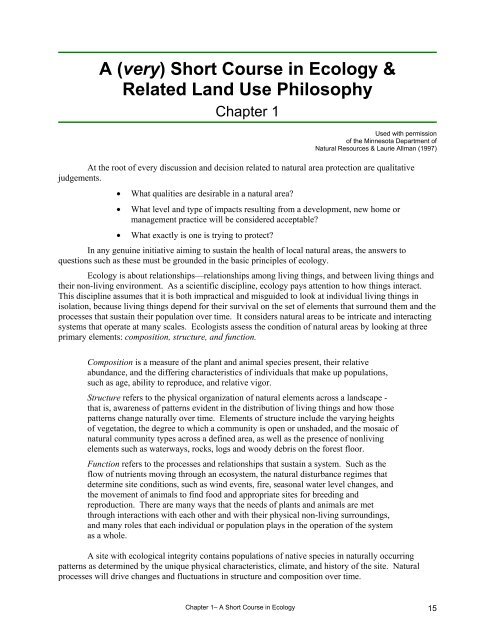Guide to Significant Wildlife Habitat - Door County Web Map
Guide to Significant Wildlife Habitat - Door County Web Map
Guide to Significant Wildlife Habitat - Door County Web Map
Create successful ePaper yourself
Turn your PDF publications into a flip-book with our unique Google optimized e-Paper software.
A (very) Short Course in Ecology &<br />
Related Land Use Philosophy<br />
Chapter 1<br />
Used with permission<br />
of the Minnesota Department of<br />
Natural Resources & Laurie Allman (1997)<br />
At the root of every discussion and decision related <strong>to</strong> natural area protection are qualitative<br />
judgements.<br />
• What qualities are desirable in a natural area?<br />
• What level and type of impacts resulting from a development, new home or<br />
management practice will be considered acceptable?<br />
• What exactly is one is trying <strong>to</strong> protect?<br />
In any genuine initiative aiming <strong>to</strong> sustain the health of local natural areas, the answers <strong>to</strong><br />
questions such as these must be grounded in the basic principles of ecology.<br />
Ecology is about relationships—relationships among living things, and between living things and<br />
their non-living environment. As a scientific discipline, ecology pays attention <strong>to</strong> how things interact.<br />
This discipline assumes that it is both impractical and misguided <strong>to</strong> look at individual living things in<br />
isolation, because living things depend for their survival on the set of elements that surround them and the<br />
processes that sustain their population over time. It considers natural areas <strong>to</strong> be intricate and interacting<br />
systems that operate at many scales. Ecologists assess the condition of natural areas by looking at three<br />
primary elements: composition, structure, and function.<br />
Composition is a measure of the plant and animal species present, their relative<br />
abundance, and the differing characteristics of individuals that make up populations,<br />
such as age, ability <strong>to</strong> reproduce, and relative vigor.<br />
Structure refers <strong>to</strong> the physical organization of natural elements across a landscape -<br />
that is, awareness of patterns evident in the distribution of living things and how those<br />
patterns change naturally over time. Elements of structure include the varying heights<br />
of vegetation, the degree <strong>to</strong> which a community is open or unshaded, and the mosaic of<br />
natural community types across a defined area, as well as the presence of nonliving<br />
elements such as waterways, rocks, logs and woody debris on the forest floor.<br />
Function refers <strong>to</strong> the processes and relationships that sustain a system. Such as the<br />
flow of nutrients moving through an ecosystem, the natural disturbance regimes that<br />
determine site conditions, such as wind events, fire, seasonal water level changes, and<br />
the movement of animals <strong>to</strong> find food and appropriate sites for breeding and<br />
reproduction. There are many ways that the needs of plants and animals are met<br />
through interactions with each other and with their physical non-living surroundings,<br />
and many roles that each individual or population plays in the operation of the system<br />
as a whole.<br />
A site with ecological integrity contains populations of native species in naturally occurring<br />
patterns as determined by the unique physical characteristics, climate, and his<strong>to</strong>ry of the site. Natural<br />
processes will drive changes and fluctuations in structure and composition over time.<br />
Chapter 1– A Short Course in Ecology 15





![A Guide to the Control and Management of Invasive Phragmites [PDF]](https://img.yumpu.com/19126786/1/190x190/a-guide-to-the-control-and-management-of-invasive-phragmites-pdf.jpg?quality=85)






![Homeowner's Guide to Japanese Knotweed Control [PDF]](https://img.yumpu.com/19126766/1/190x245/homeowners-guide-to-japanese-knotweed-control-pdf.jpg?quality=85)




